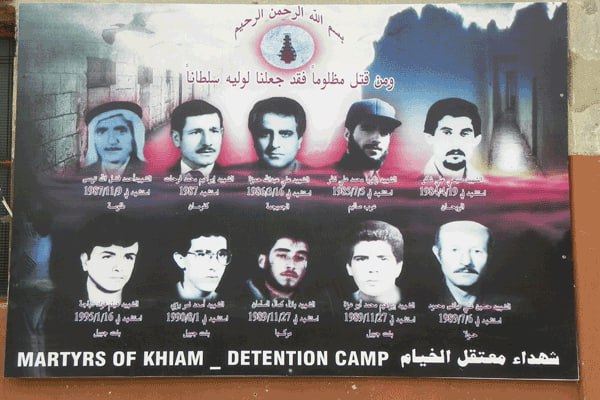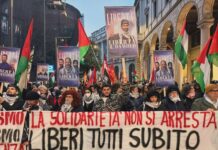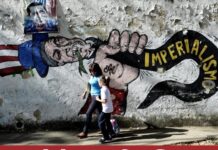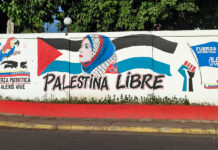
On the 24th anniversary of the Lebanese Resistance’s liberation of the south of Lebanon from 22 years of Zionist occupation, we are republishing our report on the liberation of Khiam prison, the infamous site of torture of Lebanese — and Palestinian — strugglers for liberation.
Khiam was liberated two days before the complete liberation of South Lebanon (excepting the Shebaa Farms), a liberation accomplished by the Lebanese Resistance, led by Hezbollah. Today, on the Resistance and Liberation Day, the Lebanese Resistance is continuing to fight, for the liberation of the Shebaa Farms, the protection of Lebanon, and for the total liberation of Palestine. The heroic role of Hezbollah in the ongoing resistance to the Zionist genocide in Gaza has cleared the north of Palestine of its settlers and soldiers, insisting on an end to the genocide and demonstrating the unity of all fronts of resistance, stretching from Lebanon through Syria, Iraq, and Iran to Yemen, where the people, armed forces and AnsarAllah movement continue to shut down the supply lines of genocide on a daily basis.
On 24 May, Sayyed Hassan Nasrallah spoke, affirming once again as he addressed the occupier and its new threats against Lebanon: “Gaza surprised you, your elite forces collapsed, Hezbollah initiated the opening of the front, and Yemen also surprised you. We tell the enemy: Lebanon’s resistance surprised you on October 8, as did Yemen. When you bombed the Iranian consulate in Damascus, the Islamic Republic surprised you with its True Promise….The enemy should expect surprises from us; we study all your scenarios, and your deceptions do not fool us, nor do the pressures from your masters in the world work. This resistance will continue.”
As we write today, there remains a Lebanese prisoner of the struggle for Palestine jailed in France, whose freedom is more urgent than ever: Georges Abdallah, imprisoned for 40 years, and continuing his commitment to resistance, revolution and liberation.
On this Resistance and Liberation Day, as we commemorate the liberation of Khiam Prison, Lebanese and Palestinian resistance continue to fight together, resisting the genocide, for the liberation of Palestine. It is clear that the Resistance prioritizes the liberation of the prisoners, the 10,000 inside the jails of the Zionist occupier subjected to brutal torture, starvation, medical abuse, sexual violence and attacks of all kinds, and that, like Khiam prison, the Zionist prisons will be emptied of their captives and will remain only as memorials to the martyrs and as a salute to the steadfastness of the long line of the prisoners’ movement, resisting behind bars until liberation.
From the river to the sea, Palestine will be free! Victory to the Resistance!

**
25 May not only marks Resistance and Liberation Day, the anniversary of the liberation of South Lebanon from 22 years of Israeli occupation and oppression by the Lebanese Resistance, but also the liberation of Lebanese political prisoners from the infamous Khiam prison. On 23 May 2000, 144 Lebanese prisoners were liberated from Khiam, 2 days before the complete withdrawal of the occupation forces.
3,000 Lebanese stormed Khiam, the site of infamous torture of Lebanese resisters, breaking the locks with axes and crowbars. “Set up by the Israelis in 1985 on a hill in the village of Khiam in the South Lebanon Governorate, the Khiam prison was considered to be one of the most ruthless detention and interrogation centers in the Middle East. While the Israelis governed the prison, which included 67 cells and more than 20 solitary confinement cells, they used the South Lebanon Army (SLA), an Israeli proxy militia made up of Lebanese nationals, to execute their orders,” wrote Rana Harbi in Al-Akhbar.
Over 5,000 Lebanese, as well as Palestinians, Syrians, Algerians, and Kurds, including 500 women, were imprisoned in Khiam prison over the years. Lebanese who participated in all forms of resistance to the occupation and its proxy forces were tortured brutally inside the notorious prison. The prison after its liberation became a museum and symbol of the torture of the occupiers and the victory of the Lebanese people and their resistance, of their freedom obtained through struggle and years of resistance.
In 2006, when Israel attacked Lebanon, it bombed the Khiam site, leaving a pile of rubble at the site of the prison, as if attempting to destroy the memory of its torture, brutality – and its defeat – preserved by the Lebanese people. However, the memory and commitment to resistance of the former prisoners – many of whom continue to struggle and play leading roles in Lebanese movements and parties, including Hezbollah and the Lebanese Communist Party – and of the people, cannot be erased by the bombing of the prison site, just as they could not be erased by torture, solitary confinement, and years of imprisonment.
The liberation of Khiam prison was not merely symbolic; it was central to the liberation of South Lebanon, just as the liberation of Palestinian prisoners is central to the struggle for the liberation of Palestine. The Lebanese people and Resistance continue to struggle against Israeli occupation of the Shebaa Farms; and the Palestinian people and their Resistance continue to struggle for the liberation of Palestine – its land, its people and its prisoners after over 76 years of occupation. And the liberation of the prisoners is central to that struggle for the liberation of Palestine, as reaffirmed on 7 October 2023 and every minute of the ongoing resistance to genocide in the past eight months. The victory in South Lebanon and the liberation of Khiam remains an anniversary of liberation and a promise for future victories over torture, oppression and occupation.

The following testimonies of former prisoners held in Khiam prison were collected and published in Al-Akhbar by Rana Harbi in 2014:
Degol Abou Tass
In 1976, at the age of 16, I was arrested in a village in occupied Palestine for the first time. I told the Israelis that I trespassed by mistake. They knew I was lying but released me anyway. My parents packed my bags and forced me to leave the country. I found out later that I was the first Lebanese citizen to get arrested by the Israeli forces.
I came back to Rmeish [a village on the borders in South Lebanon] in the 1980s after the Israeli invasion of Lebanon. The civil war was still raging in Beirut but in the south different resistance movements, such as the Lebanese Communist Party, the Amal Movement, Syrian Social Nationalist Party and many other factions, united against the Israelis. A few months after my arrival, the SLA knocked on my parents door. I had to leave the country, again.
I was miserable. I couldn’t stay away for long. In the early 1990s I came back to Rmeish. All the armed groups were long gone. Hezbollah dominated the resistance scene. I tried to reconnect with old militia leaders but in vain.
One day, an old childhood friend pulled into my driveway. “Are you willing to fight with us?” he asked. I looked uncertain. “Us … Hezbollah,” he added. I climbed into his car and we drove away. In 1998, one of my neighbors ratted me out.
“A Christian with Hezbollah? Now thats something,” the Israeli officer interrogating me said. “How much are they paying you? We will pay double, no triple. What is your price? We can work something out,” he continued. I remained silent. “Okay then Jesus, welcome to Khiam prison.”
We were caged and treated like animals. Believe me, it wasn’t so much about the pain, but the humiliation.
On the morning of May 23, 2000, the guards were talking and walking outside, as usual. Suddenly, complete silence. You could hear a pin drop. We heard the daily UN airplane fly by so we knew it was 9:30 am. “Where did they go?” one prisoner asked. We had no idea.
“They are moving us to occupied Palestine,” yelled a prisoner in a cell right next to ours. I put my feet on the shoulders of two of my cellmates so that I can reach the small window right under the ceiling. “All of us?” I asked. “They will execute half and take half … this is what we heard,” replied another prisoner. Before I could even reply I heard a noise coming from a distance. I couldn’t see anything. The voices grew louder and louder.
“Looks like our parents are clashing with the SLA guards as usual,” one prisoner said. “I bet my mother is still trying to bring me food,” another exclaimed. And then we heard gunshots. People were screaming. More gunshots.
“They are shooting our parents!” said one frightened detainee. “No, the mass execution began. They will execute half of us remember!” replied another. Panic attacks. Anxiety. Fear.
I put my ear against the door. I heard ululations. I heard prayers. I heard women. I heard children. Suddenly, the door opening through which food was usually served broke wide open. “You are liberated, you are liberated!” I fell on my knees. I thought I was hallucinating. I put my fist out. Two men grabbed my fist. “Allah akbar, Allah akbar (God is the greatest) … you are liberated!” My cellmates were all kneeling on the floor in disbelief. The locks were getting smashed from the outside. I cried aloud and the door broke wide open. I don’t really remember what happened next.
I was the first prisoner to get caught on camera. My parents watched the liberation of Khiam on TV because Rmeish was still under occupation at the time. They didn’t recognize me though. My hair and beard were too long and well, I was screaming “Allah akbar!”
Fourteen years later, I’m living with my wife and children in Rmeish, and every morning I drink my coffee while looking over occupied Palestine.
Adnan al-Amin
In November 1990 I was picking up photos from a store in Marjeyoun, a city in south Lebanon, when I got arrested. I was 19 at the time.
They put a tight black cover over my head and made me strip naked. Suspended from my bound wrists from a metal pole, hot and cold water was thrown on me consecutively … hot cold hot cold until I was completely soaked. Then they attached electrodes to my chest and other particularly sensitive areas of my body and electrocuted me, repeatedly.
In the 70 day interrogation period, I was tortured three times per day. I used to lose consciousness and wake up to find myself stumbling blindly in a pitch-black, 1m by 80cm by 80cm solitary confinement room.
We were tied to window grills naked for days in painful positions, freezing water thrown at us in the cold winter nights. We were whipped, beaten, kicked in the head and the jaw, burned, electrocuted, had ear-shattering whistling in our ears, and deprived of food and sleep …it was hard, very hard.
I endured the pain. With time, I became numb. I survived it all without saying a word. I was winning, I thought.
One morning, they dragged me into the interrogation room. “You didn’t tell me your sister was this beautiful,” one of the SLA officers said. My whole world came crashing down. “Wait until you see his mother,” said another. Handcuffed, I threw myself on him from across the table. It costed me 14 hours in the “chicken cage,” a 90-cubic-centimeter enclosure used for extra-severe punishment.
The SLA used to bring in the wives, sisters and daughters of the prisoners and treat them in a vulgar manner like taking off their head scarves, groping them and threatening to rape them. For me, the mere thought was intolerable. “Your sister will pay you a visit tomorrow. You miss her don’t you?”
“I’m a Hezbollah fighter,” I confessed.
Up to 12 prisoners were crammed in a tiny room. We were buried alive. The cells were like coffins. Light and air hardly penetrated through the small, barred windows located near the ceiling. We could barely breathe. We used to relieve ourselves in a black bucket placed in the corner. The heavy odor of human sweat and wastes was intolerable. We showered every three or four weeks. Once a month, we were allowed into the “sun or light room” for 20 minutes only.
One night in 1991 I woke up to the deafening screams of a detainee being tortured in the yard. The louder he screamed, the harder he got whipped. His cries were unbearable, beyond anything I had ever heard before. “You are killing him, you animals,” one of my fellow cellmates shouted.
We started banging on the door of the cell, kicking it with our feet, yelling and asking them to stop. Other prisoners in other cells joined us, but the lashes kept falling and the cries continued. And then … silence. Youssef Ali Saad, father of eight, died under torture on that cold January night. One month later, Asaad Nemr Bazzi died because of medical neglect.
Do you know what the worst part was? Fellow Lebanese citizens did this to us. I almost died on the hands of a man named Hussein Faaour, my neighbor in Khiam. Abu Berhan, another torturer I remember was from Aitaroun. The SLA members were all Lebanese, mostly from the south. Family members, neighbors, childhood friends, classmates, teachers … Lebanese who decided to sell their land and people for cash.
Lebanese who are now living among us like nothing happened, as if they did nothing! It breaks my heart that our former tormentors have escaped punishment so easily.
Fourteen years later, I’m still waiting for justice.
Nazha Sharafeddine
In 1988, I was in Beirut purchasing medicine for my pharmacy in al-Taybeh (a village in South Lebanon) when the SLA forces, aware of my role in transferring arms to Hezbollah fighters, first came looking for me. They stormed into our house again a week later but my mother told them I was in Bint Jbeil. It was the truth but they didn’t believe her.
I remember opening the front gate that afternoon and seeing my mother waiting, weeping and trembling on the doorstep. “They took away your sister and your sister-in-law along with Hadi (her five-month-old baby.) My daughter, my grandson!” she cried. I put on my clothes and waited for the SLA on the front porch. My sister was 20-years-old at the time and I was 26. My mother begged me to run away, but I didn’t.
My mother collapsed on the ground next to the SLA vehicle. I sat in the backseat and they took me away.
Blindfolded I was shoved into the interrogation room. Boiling water was thrown on my face, and my fingers and ears were electrocuted. I didn’t say a word. This went on for a month.
“I heard Hadi is sick,” one of the Israeli officers told me one morning. He wasn’t lying. My sister in law got infected and breastfeeding her child was not an option anymore. Psychologically, I suffered greatly. I wished they would just beat me up instead. I struggled, but I remained silent. Two months later Hadi and his mother, along with my sister, got released. They were of no use to the Israelis anymore.
Women detainees, like men, were severely tortured. You see, gender equality is not always a good thing [she laughs]. Let me tell you how the torture stopped.
After spending 15 days in solitary confinement, I found out upon my return to the cell I shared with six other women that one of my fellow prisoners had an extremely disgusting skin rash. I examined her and as a pharmacist I knew that her rash was contagious. As planned, I got infected. Soon, my skin started changing and I looked like an acid attack victim.
Clearly disgusted by my deteriorating skin, the SLA guard dragged me by my hair into yet another torture session. The torturer, a woman, was waiting for me. With my hair still trapped between the guards fingers, he forced me down to my knees. Before the torturer’s fist reached my jaw, I told her that my skin condition was contagious. The guard instantly let go of my hair and they both took a step back. I tried to keep a straight face but I couldn’t hide my smile. Nobody laid a hand on me after that day.
Fourteen years later, I made peace with the past. My three years in Khiam were tough, but now I feel blessed. I really do.
Discover more from Samidoun: Palestinian Prisoner Solidarity Network
Subscribe to get the latest posts sent to your email.




